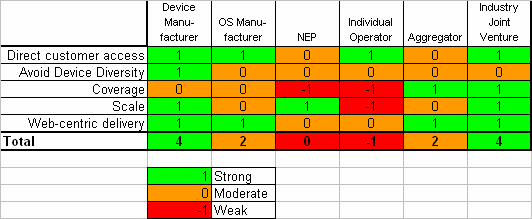Examining the factors necessary for app store success:
- Direct customer access: a critical factor in Apple’s success, and why operator third party developer initiatives continue to languish. However, this is changing. O2 Litmus was launched with direct customer access at its heart. Similarly Vodafone’s Betavine Widget Zone is also allowing direct customer access. Critically the store, whether it be for downloadable apps or network based value added services, must be pre-loaded and on the home screen of the device.
- Avoid device diversity: the bane of many operator initiatives, and the reason behind the failure of the ODP (On Device Portal – an early attempt at an app store). Apple has it easy with one device platform. RIM and Nokia are constraining the problem. For operators there’s a need to balance device coverage with the complexity it generates.
- Scale: 10s of millions of customers directly addressable, this is the critical metric for developers. And a problem for most operators, even across Orange group they could perhaps match the size of Apple’s iPhone and iPod Touch market; yet there is significant device diversity in that addressable group.
- Coverage: As seen in Norway, presenting a common front across operators to third party services promotes innovation and commercial success. Apple works great for apps that use the platform (e.g. games) or the internet, but glaringly does not use the operator’s network other than as a pipe. This is a key battle ground for operators as the market decides are they pipes to the internet or networks. Given most people’s friends are within the same country, use a variety of phones, and are on multiple networks – can operators work together to open-up the richness of Apple App Store to a broader segment of their customers?
- Web-centric operational model: Most of the apps on the iPhone are simply existing web-apps/pages; for example iphone.facebook.com and the Facebook app are the same experience. Operators have had application stores for years, yet none achieved the engagement of Apple. An important factor is being able to deliver applications / value added services in a web-centric operational model not as a traditional telco.
Given these factors, let’s now examine the groups that could offer the applications:
- Device Manufacturers: Apple, RIM, Nokia, etc. They avoid/limit the diversity problem, provide scale and direct customer access; and apart from Apple with its exclusive operator deals are available across most operators within a country.
- OS Suppliers: Android, Microsoft, etc. Similarly provide direct customer access, limit the diversity problem, in time Android will provide scale, and Microsoft will likely be limited to high-end / business phones.
- Network Equipment Providers: As NEPs are selling the service platforms that expose capabilities and ingest applications to tens if not hundreds of operators around the world, they definitely have scale. However, NEP’s delivery processes are not designed to cope with the web-centric application delivery model, their margins are too high, the process too slow and ill-equipped to cope with an app that is popular this holiday and passé next month. On coverage, because operators tend to choose different suppliers to their competitors, they will generally not provide good in-country coverage.
- Individual Operators: The group that’s been at this the longest in offering app stores; remember those walled gardens? Who now have renewed energy as Apple has worked out the recipe. However, today’s individual initiatives suffer from a lack of scale and coverage, and struggle with adopting a web-centric operational model.
- Aggregators: They started with SMS, enabling applications to have a single interface across multiple operators, and expanded to MMS and location; so why not provide an aggregation point for applications? As operators realize they can also perform such aggregation roles, it’s a business model potentially under threat. In addition, they are dependent on the operator opening up access to customers, and are not adept at managing the device diversity problem.
- Industry joint venture: This could be considered a wishful state, but other industries have achieved such JVs. Operators create a single entity across the industry to present a common ingestion method for apps, its operated as a web business not a telco business (but backends into telcos). Enabling rapid ingestion, global coverage, mitigating device diversity as aggregating networks achieves a critical scale when the addressable base is perhaps over one billion.
Below is a simple comparison of the groups against the success factors. The market has shown device manufacturers can be an appropriate channel. But what is surprising is how NEPs and individual operators perform so poorly against the factors necessary for app store success. The time for coordinated industry action in creating a JV is now.

Ciao Alan,
I’ve reached your blog today for the first time and I noticed that we are on the same views very often.
take the chance to visit Meedabyte if you want.
keep on!
Hi Alan,
Nice Blog!! You are doing great job by bringing key topics into limelight, which will define the way (about how and where) Telecom industry can and should proceed…
By the way in this post, you didn’t touched a very important topic related to App Development Industry… i.e. Revenue Sharing.
Revenue Share percentage to App Developers is one of the key difference between the Operator offerings and what Apple offers..
Apple has reversed the Revenue share scenario by giving more to the App developers and hence have encouraged them to make more and more applications, giving more variety to the end users, which means more sales, more revenues…
And other device manufacturers (like Nokia, RIM etc) have also started taking this route.
So this is one of the key option on how the Telco industry can work better with the App Development Industry…
BR,
–Manish Agrawal